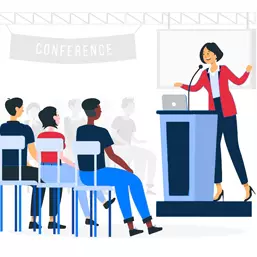
Preparing for a Presentation
Speak clearly, if you speak at all; carve every word before you let it fall.
– Oliver Wendell Holmes Sr.
What is a presentation?
A presentation is a kind of communication that may be customized for a range of speaking situations, including addressing a gathering, addressing a meeting, or briefing a team. It may be a presentation highlighting your organization’s accomplishments, what you can offer a prospective employer, or why you should be awarded more funding for a project. Additionally, the term ‘presentation’ may be used to refer to other speaking engagements, such as delivering a wedding speech or presenting a point via a videoconference.

If you want to give an effective presentation then the preparation process, as well as the approach and techniques of presenting the material, should be thoroughly explored in advance. The most important part of your preparation is deciding your purpose. Whether your goal is to persuade or to inform, you must have a clear idea of what you want your listeners to remember or do.

Warm up exercise
List five qualities that you feel are needed to give a good presentation. The purpose of this exercise is to get learners thinking about their current set of presentation skills as well as the presentation skills gap as they are learning along the way.
Brief check
The main purpose of preparing for a presentation is to identify your purpose and know your audience.
Key elements in preparing your presentation
1. Audience
The audience’s understanding of the presenter’s message is often filtered and modified by factors such as the listener’s own experience, knowledge, and personal sense of values. The audience’s reaction, and therefore the presentation’s success, will be largely influenced by whether you, as the presenter, successfully communicated your message and met their expectations.
The following questions are imperative to ask in relation to the audience before your presentation. These questions will serve as audience analysis and help you to prepare your presentation accordingly. Think of answers to the following questions –
- What might the audience expect to hear?
- What do they want to gain from the presentation?
- How do they pay attention?
- What will they recall?
- What will turn them on or off, make them feel comfortable or uneasy?
- What language do they communicate in?
- What might they already know about the topic?
- What will their inquiries be?
- What will they find difficult to hear?
- What are their business requirements (if it’s relevant)?
- Can you? Or how will you analyse their reaction?
- What may cause them to be hostile?
- How will you obtain their feedback?
When you really understand your target audience and deliver to them, you will convey that you respect them. Your audience will sense that you have invested your time an effort and as a result, delivering your presentation will be considerably easier.
Audience types
Understanding four different audience types below will help you decide how to organize your presentation.
| Audience
Members |
Organisational Pattern | Delivery
Style |
Supporting
Material |
| Friendly: They like you and your topic | Use any pattern; try something new; involve the audience | Be warm, pleasant, open; use lots of eye contact, smiles | Include humour; personal examples and experiences |
| Neutral: They are calm, rational; their minds are made up but they think they are objective | Present both sides of issue; use pro-con or problem-solution patterns; save time for audience questions | Be controlled; do nothing showy; use confident, small gestures | Use facts, statistics, expert opinion, comparison and contrast; avoid humour, personal stories, and flashy visuals |
| Uninterested: They have short attention spans; they may be there against their will | Be brief; no more than three points; avoid topical and pro-con patterns that seem lengthy to audience | Be dynamic and entertaining; move around, use large gestures | Use humour, cartoons, colourful visuals, powerful quotations, startling statistics |
| Hostile: They want to take charge or to ridicule speaker; defensive, emotional | Use non controversial pattern such as topical, chronological or geographical | Be calm, controlled;
speak evenly and slowly |
Include objective data and expert opinion; avoid anecdotes and humour. |
Other elements such as age, gender, education, experience, and size of audience will also affect your style and message content.
Brief check
-If the audience is uninterested then avoid darkening the room, standing motionless, passing out hand-outs, using boring visuals or expecting audience to participate.
-If the audience is hostile then avoid question and answer session. You may use a moderator if you really have to do Q&A or only accept written questions.
Presenter
It is the presenter’s obligation to connect with the audience and to keep the presentation on track. However, keep in mind that this may also imply giving up authority to your audience, particularly if you desire some kind of involvement. Many factors may influence how effectively the audience receives your message.

Background noise or other distractions, an exceptionally hot or cold location, or the time of day and state of audience consciousness, for example, may all have an effect on your audience’s level of attention. As a presenter, you must be prepared to deal with such challenges while maintaining your audience’s attention on your subject.
Prior to your presentation if you answer some of the following questions, it will prepare you to give your best performance as a presenter.
- What brings you here?
- What do you hope to accomplish?
- What do you look like, and how do you sound?
- What are your plans for dealing with nerves?
- How will you practice?
- How will you remember what you’re going to say?
- What exactly is charisma?
- How will you respond to questions?
- What are you going to do if they are hostile?
- How will you maintain your energy?
- How will you respond if you are being questioned?
- Is a Chairman or Master of Ceremonies required?
- How are you going to introduce yourself?
- Is there a more efficient method to deal with technology?
3. The Presentation
You most likely already have a subject in mind and know exactly what you want to say about it. This is the presentation’s material and you may already have the material of your presentation written down. Whether your information is already written or you are starting from fresh, you may need to condense it for your presentation. You must fit your material inside the time constraints. Consider how much information you can realistically give in the time allotted and choose the most significant topic.
You must keep your audience’s interest and attention. Many individuals lose interest at the conclusion of presentations that include excessive amounts of information. Consider carefully the important ideas you want to convey and structure your presentation around them.
Technical explanations and tables of numbers, for example, are difficult for listeners to comprehend during a presentation. Consider summarizing this kind of material or directing listeners to a paper that they may read after the presentation.
You must provide time for examples and demonstrations of your arguments. Consider how you will support and clarify your main ideas.
You must provide time for an introduction, a conclusion, and questions or remarks. During this period, you will most likely be repeating ideas made in the major body of your presentation.
When planning the topic of a presentation, consider the following three points:
- What are the main points you want to make? Most effective presentations include no more than five main topics.
- How will you use examples and illustrations to support your main points?
- How will you make it simple for your audience to understand your main points?
Practical Application
GBL is a global leader in wellness business. It’s geographically diverse workforce comes together annually in various parts of the Asia Pacific region. Jane Smith who has been a learning and development consultant for over a decade was supposed to design and deliver a bespoke Presentation Skills course to the staff in the upcoming GBL conference. Jane was given the task to lead the presentation skills training and so she had to develop the entire program to suit the needs of the diverse group of audience who varied in their educational background as well as work demands. Some of those delegates had to be trained to speak at product launches, while some required to present in a variety of contexts, internal briefing sessions and sales pitches to clients. Jane therefore needed to design a course, which seemed like it was personalized to the needs of each individual, developing their skills and exploring how they might adapt their approach to suit both formal and informal settings.
To face this challenge, Jane decided to explore the business needs and context of all the delegates. After that she noted down the most common elements required by all types of presenters based on which she designed the presentation, which was highly practical for all the audience. Jane covered topics such as –
- What makes a good presenter (focusing on generating credibility, using visual aids, vocal techniques and stagecraft)
- How to select and organize your material.
- How to use PowerPoint and create effective slides.
- How to promote audience engagement.
- How to handle Q&A sessions and deal with challenges from the audience.
- How to manage nerves.
- How to prepare your voice before presenting.
All the presentations were videoed, to give the delegates a permanent record to support their development. The course evaluation forms and anecdotal feedback from the delegates praised the relevance of the material and the participative nature of the events.





